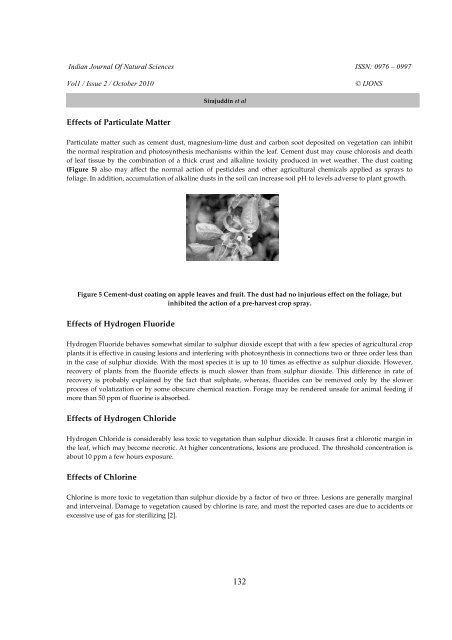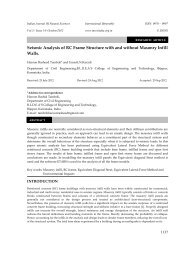Agroecology for Sustainable Food Security - tnsroindia.org.in
Agroecology for Sustainable Food Security - tnsroindia.org.in
Agroecology for Sustainable Food Security - tnsroindia.org.in
You also want an ePaper? Increase the reach of your titles
YUMPU automatically turns print PDFs into web optimized ePapers that Google loves.
Indian Journal Of Natural Sciences ISSN: 0976 – 0997<br />
Vol1 / Issue 2 / October 2010 © IJONS<br />
Effects of Particulate Matter<br />
Particulate matter such as cement dust, magnesium-lime dust and carbon soot deposited on vegetation can <strong>in</strong>hibit<br />
the normal respiration and photosynthesis mechanisms with<strong>in</strong> the leaf. Cement dust may cause chlorosis and death<br />
of leaf tissue by the comb<strong>in</strong>ation of a thick crust and alkal<strong>in</strong>e toxicity produced <strong>in</strong> wet weather. The dust coat<strong>in</strong>g<br />
(Figure 5) also may affect the normal action of pesticides and other agricultural chemicals applied as sprays to<br />
foliage. In addition, accumulation of alkal<strong>in</strong>e dusts <strong>in</strong> the soil can <strong>in</strong>crease soil pH to levels adverse to plant growth.<br />
Figure 5 Cement-dust coat<strong>in</strong>g on apple leaves and fruit. The dust had no <strong>in</strong>jurious effect on the foliage, but<br />
<strong>in</strong>hibited the action of a pre-harvest crop spray.<br />
Effects of Hydrogen Fluoride<br />
Hydrogen Fluoride behaves somewhat similar to sulphur dioxide except that with a few species of agricultural crop<br />
plants it is effective <strong>in</strong> caus<strong>in</strong>g lesions and <strong>in</strong>terfer<strong>in</strong>g with photosynthesis <strong>in</strong> connections two or three order less than<br />
<strong>in</strong> the case of sulphur dioxide. With the most species it is up to 10 times as effective as sulphur dioxide. However,<br />
recovery of plants from the fluoride effects is much slower than from sulphur dioxide. This difference <strong>in</strong> rate of<br />
recovery is probably expla<strong>in</strong>ed by the fact that sulphate, whereas, fluorides can be removed only by the slower<br />
process of volatization or by some obscure chemical reaction. Forage may be rendered unsafe <strong>for</strong> animal feed<strong>in</strong>g if<br />
more than 50 ppm of fluor<strong>in</strong>e is absorbed.<br />
Effects of Hydrogen Chloride<br />
Hydrogen Chloride is considerably less toxic to vegetation than sulphur dioxide. It causes first a chlorotic marg<strong>in</strong> <strong>in</strong><br />
the leaf, which may become necrotic. At higher concentrations, lesions are produced. The threshold concentration is<br />
about 10 ppm a few hours exposure.<br />
Effects of Chlor<strong>in</strong>e<br />
Sirajudd<strong>in</strong> et al<br />
Chlor<strong>in</strong>e is more toxic to vegetation than sulphur dioxide by a factor of two or three. Lesions are generally marg<strong>in</strong>al<br />
and <strong>in</strong>terve<strong>in</strong>al. Damage to vegetation caused by chlor<strong>in</strong>e is rare, and most the reported cases are due to accidents or<br />
excessive use of gas <strong>for</strong> steriliz<strong>in</strong>g [2].<br />
132



